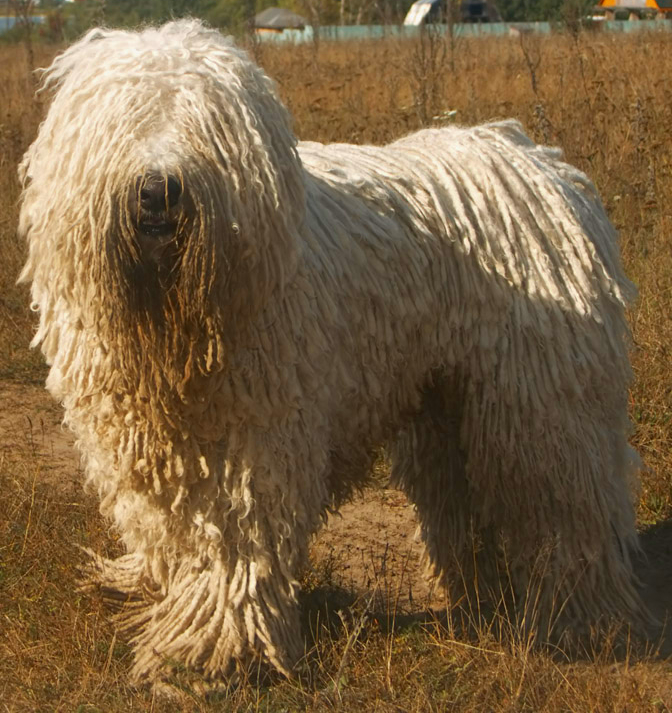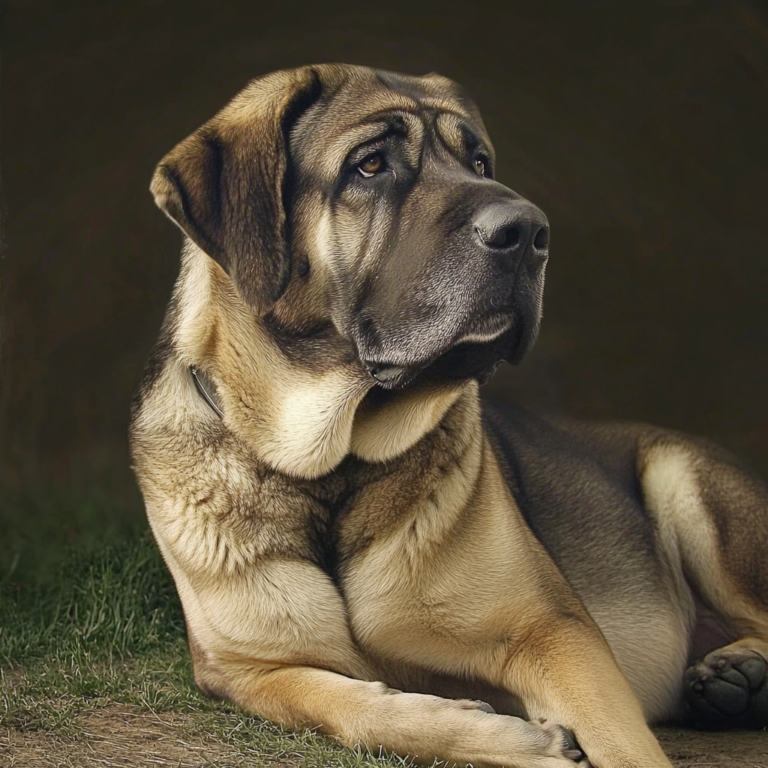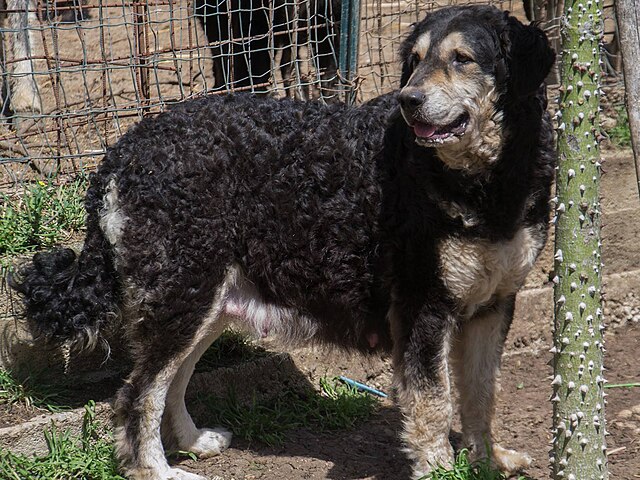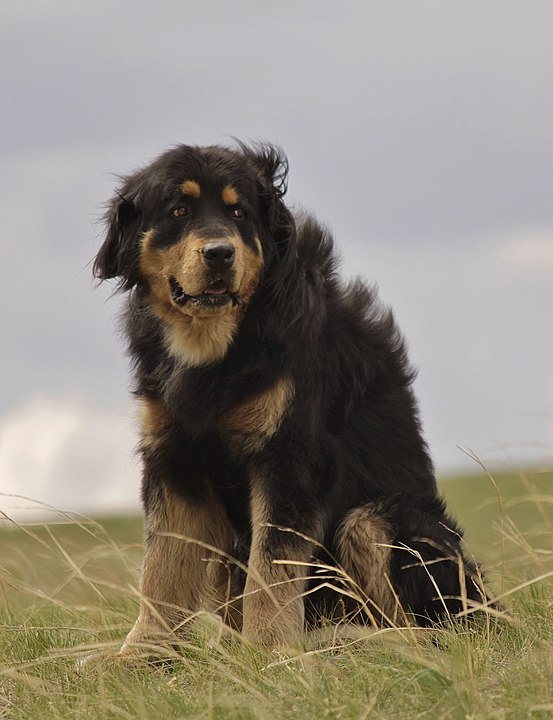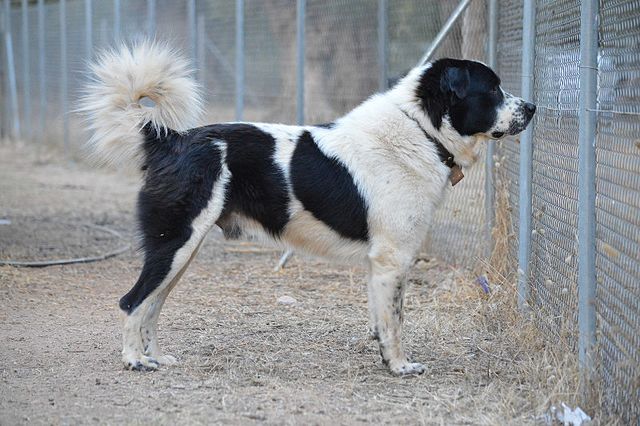The Komondor is known for his distinctive long, corded coat and his unsurpassed livestock guardian abilities. This is not a herding dog, but instead a dog that specialized in watching over flocks in his native Hungary. To do this job meant that he had to be fearless and brave – often facing off against wolves and other predators. Protecting is in his blood, and even today’s Komondor needs something (or someone) to protect. Not every owner needs to have a flock of sheep, but a child or even a cat can fill this need. This trait is so ingrained that prospective owners are urged to visit an adult Komondor at the owner’s house before they buy. This way they can see for themselves just how protective the breed is, and decide whether it is the right breed for them!
This is a relatively calm and quiet breed as long as there are no intruders onto the property (although some bark more than others – there is a range from very quiet to quite loud). Either way, he should have a steady, even temperament. If someone comes near though… he will erupt into a series of warnings. If his warnings are not taken seriously he will act! Komondorok (the plural of Komondor) have been known to break through windows if they think that their charge needs protecting. Strangers must be introduced to the dog by the owners before entering the house. This way the dog knows that the person is “ok”, and will allow them into “his pack”. Most will continue to remember that person throughout their life, and may even consider that person worthy of protecting as well! This breed is excellent at being able to tell if someone has bad intentions, however – if the dog doesn’t seem to accept someone, there might be a reason why…
There are countless stories detailing Komondorok that warned of danger (such as fires), fought off attackers, and protected their masters. All of these tales speak of the great devotion that the breed has toward their owners. This loyalty is not matched by many other breeds, which is also what makes them ironically difficult and even dangerous if not raised correctly. These dogs live and breathe protection. They follow their charges from room to room, even leaning against the person if they feel the need to be closer. They will make decisions about how best to protect that person – often intelligently but not always socially acceptable.
This is a serious guard dog meant only for serious owners who understand how protective they are! The fact that the Komondor is also large and powerful means that they can do a lot of damage. Obedience training from a young age, as well as continuous rules and structure, are paramount. Komondorok were bred to be independent and to think for themselves. They are cunningly intelligent, but may take advantage of owners who don’t stay consistent with the rules. Although they can take very well to training, it’s best if that training is started early on, before they get to their “testing phase”. They should never be allowed to get away with pushy behavior, as it can potentially escalate into aggressive actions (the breed is not shy about biting). This breed also needs extensive socialization when they are puppies. A Kom that has skipped the socialization stage is more prone to behave aggressively.
Despite being a giant dog, the Komondor is surprisingly athletic and light on his feet. This is not an oaf-ish creature, despite how he may look. He is loving and friendly to everyone in the family, including children (with whom he is exceptionally gentle). Puppies are silly and carefree, but gradually grow into serious and “responsible” adults as they age – although this breed does take a while to mature. Most take about three years to reach adulthood. The middle “teenage” stage is the most difficult to live with, dogs will be more destructive and will test their dominance limits. Lovers of these dogs insist that the wait is worth it, however. A well-bred, well socialized Kom at maturity has a loyalty and sense of responsibility that is unmatched in the dog world.
The Komondor who is bought to be used as a livestock guarding dog should be introduced to “his charges” while he is still young, although always under supervision. It can take anywhere from 6 months to 2 years before the dog will start to guard the flock – before he figures it out, he will probably try to chase or play with the animals instead! Some people buy a Komondor and keep it outside 24/7. Unlike most breeds, the Kom can be fulfilled living in this way, although might also become even more suspicious of strangers. Older, retired working dogs have been able to be successfully integrated into the household with little trouble, however. On the other hand, dogs that live primarily indoors and guard family rather than flock, do not like to be outside if they cannot see their charges. They can get very anxious if they can’t do their job.
Despite their size, many Komondorok do not need a lot of food to keep them happy and at an ideal weight. In fact, the serving guidelines on dog food bags are often too high for what this breed needs. Keep in mind, also, that adult Koms are very inactive and do not require a lot of exercise. The combination of these two factors can mean that weight gain is a concern. Owners need to monitor the dog’s weight to make sure he stays healthy. On the plus side, this means that the breed can live in an apartment with only a little bit of added exercise, or in a property with a yard with barely any exercise.
The distinctive coat of the Komondor is functional to the working dog. Always white in color, the dog was bred to “blend in” with the sheep, while also making him easier to be seen by the farmer at night. The long cords served at regulating temperature and protected the dog from wolf or coyote attacks. However impressive, the coat does take quite a bit of work to form its shape and stay clean. The cords need to be helped along while the dog is young, separating them from other cords and fixing them into the final shape. As far as staying clean – it is said that it is easier to keep the dog clean in the first place then to wash the dog after he has already gotten dirty! A wet Komondor can be smelly and even get mildew, so ensuring the dog stays dry is important. Owners should have large dog dryers on hand for when the dog gets soaked. It is safe to say that working Koms who live outside all of the time look (and smell) very different from most Koms kept as pets and show dogs!
The Komondor doesn’t always play nice with other dogs, especially if he feels like they are entering his territory. His sense of property is very strong and he usually knows where the boundaries are – where he belongs and other dogs do not! And while he gets along very well with children in his own family, a child that climbs over the fence and onto his property is considered an intruder and he will act accordingly…
